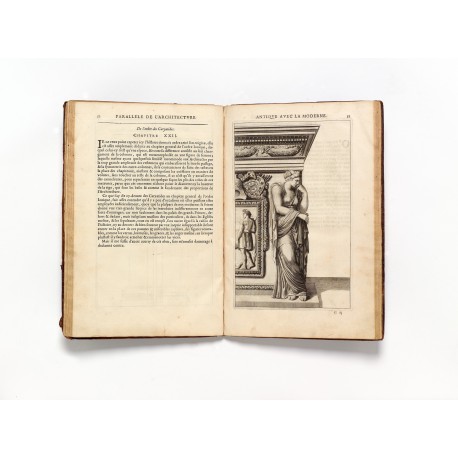 View larger
View larger
Parallèle de l’architecture antique et de la moderne: avec un recueil des dix principaux autheurs qui ont écrit des cinq Ordres
- Subjects
- Architectural books - Early works to 1800
- Architecture, French - Early works to 1800
- Book illustration - Artists, French - Errard (Charles), c. 1606/1609-1689
- Authors/Creators
- Fréart de Chantelou, Roland, sieur de Chambray, 1606-1676
- Artists/Illustrators
- Fréart de Chantelou, Roland, sieur de Chambray, 1606-1676
- Tournier, Georges, active 1650
- Tournier, Jean Jacques (?), active 1650
- Printers/Publishers
- Martin, Edmé, active 1642-1670
- Owners
- Besterman, Theodore, 1904-1976
- De Legendre (17th century)
- Other names
- Sublet des Noyers, François, 1588?-1645
Fréart de Chantelou, Roland, sieur de Chambray
Le Mans 1606 – 1676 Le Mans
Parallèle de l’architecture antique et de la moderne: avec un recueil des dix principaux autheurs qui ont écrit des cinq Ordres.
Paris, Edmé Martin, 1650
folio (370 × 240 mm), (62) ff. signed a6 A–O4 and paginated (12) 1–109 (3); engraved title-page, forty full-page engravings, numerous smaller engraved vignettes and ornaments imposed with the text.
provenance title inscribed De Legendre — Theodore Besterman (1904–1976), exlibris1 — by his bequest to the Taylor Institution Library, University of Oxford (deaccessioned 1984) — E.P. Goldschmidt & Company Ltd. — Private Collection, Dublin
Binding abraded, otherwise in very good state of preservation.
binding contemporary French calf; back decorated in gilt.
First edition of this important text on the rules and proportions of the Orders of Columns, an epitome of the standard works on the subject by Palladio, Scamozzi, Serlio, Vignola, and other Italian and French authorities. It comprises a series of explanatory texts and visual comparisons showing how the Orders were employed by ancient and Renaissance architects and roundly condemns their incorrect usage and attempts at reform on the part of many architects. The book inaugurated the architectural part of the celebrated ‘Quarrel between the Ancients and Moderns’.2 Four subsequent editions of the Parallèle were published at Paris and John Evelyn’s translation, A Parallel of the ancient architecture with the modern (1664), went through as many editions in London.3
The engraved title with oval portrait of the author’s cousin and instigator of the book, François Sublet de Noyers (1578–1645), is signed Tournier scul., presumably Georges or Jean Jacques Tournier, the latter graveur du Roi and active circa 1650–1684; the engraving on page 63 is signed t. The other plates are unsigned works by Charles Errard (1601/1609–1689),4 who had met the author at Rome in 1640,5 where they had obtained casts of classical capitals and completed drawings of classical antiquities as study materials.6 After Errard’s return to Paris in September 1643, these drawings were translated onto copper plates.7
references Katalog der Ornamentstichsammlung der Staatlichen Kunstbibliothek Berlin (1939), no. 2374; Laurence Hall Fowler and Elizabeth Baer, The Fowler architectural collection of the Johns Hopkins University. Catalogue (Baltimore 1961), no. 127; Leopoldo Cicognara, Catalogo ragionato dei libri d’arte e d’antichità posseduti dal Conte Cicognara (reprint Bologna 1979), no. 507; Architectural theory and practice from Alberti to Ledoux, exhibition catalogue edited by Dora Wiebenson (Chicago 1983), iii–A–14; National Gallery of Art, The Mark J. Millard Architectural Collection, i: French books (Washington, dc 1993), no. 76; Avery’s choice: Five centuries of great architectural books, edited by Adolf Placzek (New York 1997), p.59 no. 78; Architectural theory: from the Renaissance to the present: 89 essays on 117 treatises, with a preface by Bernd Evers and an introduction by Christof Thoenes (Cologne 2003), pp.240–247; critical edition (with the author’s Idée de la perfection de la peinture) and commentary by Frédérique Lemerle-Pauwels and Milovan Stanic (Paris: École Nationale Supérieure des Beaux-Arts, 2005)
1. The copy is described in Besterman’s Old art books (London 1975), p.42 with reproduction pl. 62.
2. Frédérique Lemerle, ‘Une querelle des Anciens et des Modernes en architecture: Fréart de Chambray’ in Architectes et architecture dans la littérature française, edited by Madeleine Bertaud (Paris 1999), pp.37–47; for additional literature, see Lemerle’s entry in the CESR database ‘Architectura / Les livres d’Architecture’ (link).
3. See British Architectural Library, Early printed books 1478–1840 (London 1995), ii, no. 1132; Eileen Harris, British architectural books and writers, 1556–1785 (Cambridge & New York 1990), pp.196–201.
4. Jacques Thuillier, ‘Propositions pour Charles Errard, peintre’ in Revue de l’art 40–41 (1978), pp.145, 165, 169, 172. Errard’s oeuvre as established by Emmanuel Coquery comprises about 400 drawings and 500 prints; see his thesis ‘Charles Errard: ou l’ambition du décor’ (Université de Paris Sorbonne, 2004); Emmanuel Coquery, ‘La poétique ornementale de Charles Errard’ in Rinceaux et figures: l’ornement en France au xviie siècle, edited by Emmanuel Coquery (Saint-Rémy-en-l’Eau 2005), pp.28–43; Emmanuel Coquery, Charles Errard: la noblesse du décor (Paris 2013), pp.361–366 nos. 182–235.
5. Isabelle Pantin, Les Fréart de Chantelou: une famille d’amateurs au xviie siècle entre Le Mans, Paris et Rome (Le Mans 1999), p.26 and passim.
6. Roland Fréart de Chambray, ‘Proportions que jay mesurées avec Mons. Erard sur les originaux mesmes a Rome lannee 1640’ (Paris, Bibliothèque des Beaux-Arts, Ms 12 PC 6415); see Pantin, op. cit., pp.47–53; Annalisa Avon, ‘Su alcuni esempi di scultura e architettura antiche nel Parallèle (1650) di Roland Fréart de Chambray e Charles Errard’ in Annali di architettura 13 (2001), pp.111–119.
7. The frontispiece portrait of Sublet de Noyers was also engraved after a drawing by Errard (Albi, Musée Toulouse-Lautrec); see Pantin, op. cit., p.21 (reproduced).



